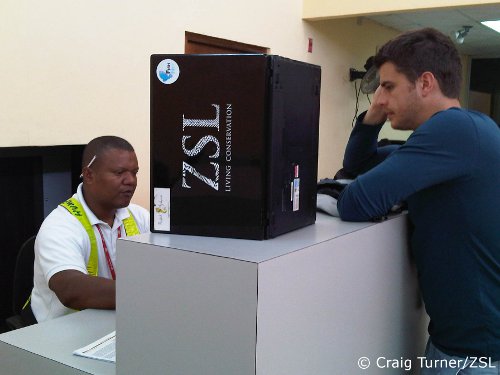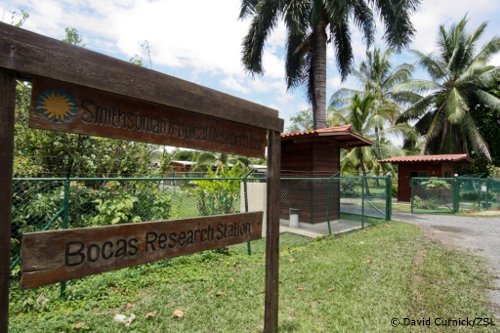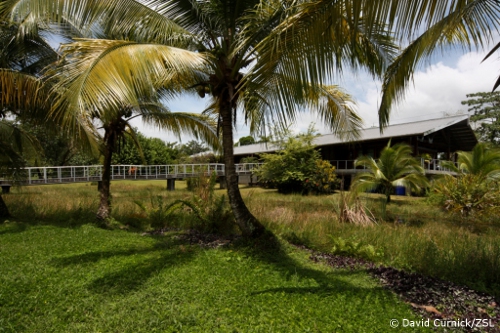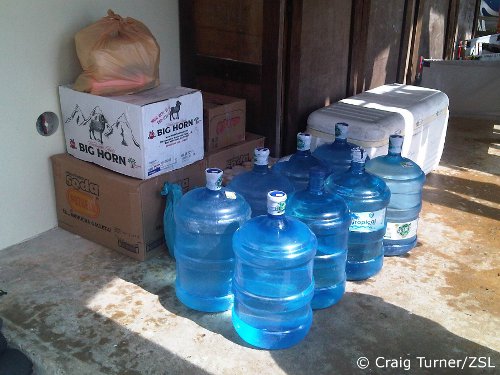After 13 months of project planning, fund raising and reviewing the available literature, Craig Turner and I were at the stage of actually procuring equipment and field supplies ahead of our expedition to Panama in search of the Critically Endangered Pygmy Three-toed Sloth (Bradypus pygmaeus). Amongst the usual kit requirements, head torches, hammocks, insect repellent and alike, we also required eight large dry-bags. These would prove essential purchases as the pygmy sloth inhabits only one small island ~ Isla Escudo de Veraguas. Sitting 17km off the Caribbean coast of mainland Panama and the only way to get to the island is via (a very wet) three hour boat ride from Bocas Del Toro.

Upon arrival in Panama City, Craig and I immediately met with our in-country project partner, Lenin Riquelme. Lenin is the executive director of Conservation, Nature and Life (CONAVI), a Panamanian NGO, and has been integral in developing the project.
Together we went about planning a much needed conservation workshop in Panama City, with the aim of bringing together all of the relevant stakeholders to discuss the future of the pygmy sloth and its habitat.
After a day or so, Craig and I travelled to Bocas Del Toro leaving the rest of the workshop planning in Lenin’s capable hands. After an unsociably early flight at 6:30am, we arrived in Bocas far from being bright eyed and bushy tailed! Nevertheless, we checked in to our accommodation and went to the Smithsonian Tropical Research Institute where we met Gabriel Jacome, the station manager, to discuss travel arrangements for getting to Escudo. Although we had been in regular email contact with Gabriel, months in advance, it became apparent very quickly that things are achieved much faster when discussed face to face.


Within an hour of our arrival, Gabriel had arranged for us to meet Marlin – a potential boat captain. A man of American descent but who grew up in the area, Marlin had been highlighted as one of two potential captains who would be willing to escort us to Escudo and assist us in our search for the pygmy sloths. However, our enthusiasm and excitement were soon shattered when Marlin told us that it would be impossible to travel to Escudo for at least another ten days due to bad weather. This news was perplexing considering the blazing sun and clear blue skies we could see through the window behind him. Marlin explained that a large swell was heading in our direction from the Caribbean Sea and that it would be far too dangerous to set sail. Devastated by the news we exchanged contact details with Marlin and agreed to keep an eye on the weather in the hope of an opening. We departed for lunch to try and lift our spirits.
We sat in the restaurant and considered the implications of the news we had just received. It dawned on us that we may not be able to travel to Escudo at all this trip and would have spent much of our funding getting this far only to be scuppered by freak weather. To add to our concerns, Alanna Maltby, a bat expert from ZSL, was due to join us tomorrow for 11 days with the plan to survey the unique bat communities that also inhabit Escudo. It was at this point that we met Gustavo, a chef from the local town who we had lined up as expedition cook a few weeks earlier. He was affectionately known to his friends as ‘fried beans’ as this was his speciality. Gustavo was ready and raring to go to Escudo and seemed undeterred by the news Marlin had given us. It turned out that Gustavo had his own boat, own captain and all the cooking gear you could imagine – our spirits began to lift.
However, we still needed to find ourselves a captain and a boat to transport us and our mountain of equipment. We had heard of a captain used regularly by the Smithsonian named Sebastian. It turned out he was well known to Gustavo, so a couple of phone calls later we soon arranged a meeting with him that afternoon to see if he could give us some better news.
Sebastian was an ex-military, Panamanian national and had been captaining boats for the Smithsonian for the last 23 years. What Sebastian didn’t know about boats and the local waters simply wasn’t worth knowing. We sat down soon after lunch and explained to him our predicament and, without thinking twice, Sebastian said ‘no problem’, a statement that soon became his catchphrase. He explained that we could leave in three days as he needed that long to collect supplies for the trip and hire a sea-worthy boat from a friend. Sebastian regaled in stories of his passed conquests at sea, his unparalleled experience and that he knew exactly where the sloths lived and how we could find them. As for the predicted weather, this was of course ‘no problem’. For trips such as these, local knowledge is often priceless and on this occasion it definitely turned out to be the case!

We spent the next few days buying the last minute essentials like food, water and fuel and also greeted Alanna as she arrived from Panama City. However, on the eve of our departure to Escudo, the weather took a turn for the worse much like Marlin had forecast. Large swells had formed out to sea and it dawned on us that our trip to Escudo may no longer be the ‘no problem’ that Sebastian was anticipating…
To be continued…